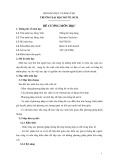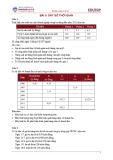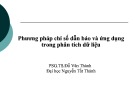Chapter 5
Discrete Random Variables
McGrawHill/Irwin
Copyright © 2014 by The McGrawHill Companies, Inc. All rights reserved.
Discrete Random Variables
5.1 Two Types of Random Variables 5.2 Discrete Probability Distributions 5.3 The Binomial Distribution 5.4 The Poisson Distribution (Optional) 5.5 The Hypergeometric Distribution
(Optional)
5.6 Joint Distributions and the Covariance
(Optional)
52
LO5-1: Explain the difference between a discrete random variable and a continuous random variable.
5.1 Two Types of Random Variables
Random variable: a variable that assumes numerical values that are determined by the outcome of an experiment ◦Discrete ◦Continuous
Discrete random variable: Possible values can be
counted or listed ◦The number of defective units in a batch of 20 ◦A listener rating (on a scale of 1 to 5) in an AccuRating
music survey
Continuous random variable: May assume any
numerical value in one or more intervals ◦The waiting time for a credit card authorization ◦The interest rate charged on a business loan
53
LO5-2: Find a discrete probability distribution and compute its mean and standard deviation.
5.2 Discrete Probability Distributions
The probability distribution of a discrete random variable is a table, graph or formula that gives the probability associated with each possible value that the variable can assume
54
Notation: Denote the values of the random variable by x and the value’s associated probability by p(x)
LO5-2
Discrete Probability Distribution Properties
p(x) (cid:0)
0
1. For any value x of the random variable,
2. The probabilities of all the events in the sample space must sum to 1, that is…
xp
1
x
all
55
(cid:0) (cid:0) (cid:0) (cid:0)
LO5-3: Use the binomial distribution to compute probabilities.
5.3 The Binomial Distribution
characteristics…
1. Experiment consists of n identical trials 2. Each trial results in either “success” or “failure” 3. Probability of success, p, is constant from trial
to trial
The binomial experiment
1. Trials are independent
The probability of failure, q, is 1 – p
trials of a binomial experiment, then x is a binomial random variable
56
If x is the total number of successes in n
LO5-3
Binomial Distribution Continued
For a binomial random variable x, the probability of
x successes in n trials is given by the binomial distribution:
(cid:0) (cid:0)
=xp
xnxqp
(cid:0) (cid:0)
n ! xnx !
!
n! is read as “n factorial” and n! = n × (n1) × (n2)
× ... × 1
0! =1 Not defined for negative numbers or fractions
57
LO5-4: Use the Poisson distribution to compute probabilities (Optional).
5.4 The Poisson Distribution
occurs over an interval of time or space, and assume that
1. The probability of occurrence is the same for
any intervals of equal length
2. The occurrence in any interval is independent of an occurrence in any nonoverlapping interval
Consider the number of times an event
58
If x = the number of occurrences in a specified interval, then x is a Poisson random variable
LO5-5: Use the hypergeometric distribution to compute probabilities (Optional).
5.5 The Hypergometric Distribution (Optional)
◦r of these are successes ◦(Nr) are failures
Population consists of N items
replacement, the probability that x of the n items will be successes is given by the hypergeometric probability formula
If we randomly select n items without
r x
xP )(
(cid:0) (cid:0) (cid:0) (cid:0) (cid:0) (cid:0) (cid:0) (cid:0) (cid:0) (cid:0) (cid:0) (cid:0) (cid:0) (cid:0) (cid:0) (cid:0) (cid:0) (cid:0) (cid:0)
rN xn N n
59
(cid:0) (cid:0) (cid:0) (cid:0) (cid:0) (cid:0) (cid:0) (cid:0)
LO5-5
The Mean and Variance of a Hypergeometric Random Variable
Mean
(cid:0) (cid:0)
(cid:0)
(cid:0) (cid:0) (cid:0)
n
x
(cid:0) (cid:0)
r N
Variance
2
(cid:0) (cid:0) (cid:0) (cid:0) (cid:0) (cid:0) (cid:0)
(cid:0)
x
(cid:0) (cid:0) (cid:0) (cid:0) (cid:0) (cid:0) (cid:0) (cid:0)
n
1
(cid:0) (cid:0) (cid:0) (cid:0) (cid:0) (cid:0) (cid:0)
r N
r N
nN N 1
510
LO5-6: Compute and understand the covariance between two random variables (Optional).
5.6 Joint Distributions and the Covariance (Optional)
511
LO5-6
Four Properties of Expected Values and Variances
1.
2.
ax=a2σ2
x
3.
◦ Also, σ2
If a is a constant and x is a random variable, then μax=aμx If x1,x2,…,xn are random variables, then μ(x1,x2,…,xn)= μx1 + μx2 + … + μxn If a is a constant and x is a random variable, then σ2 If x1,x2,…,xn are statistically independent random variables, then the covariance is zero x1+ σ2
(x1,x2,…,xn)= σ2
x2+…+ σ2
xn
512
4.


























